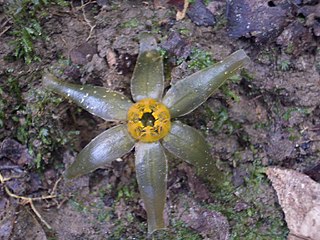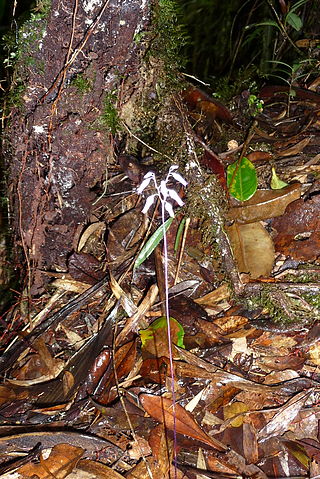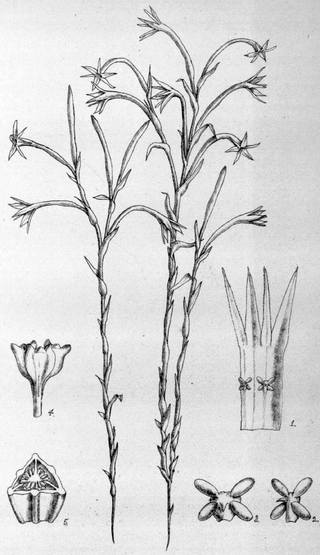
Royal Botanic Gardens, Kew is a non-departmental public body in the United Kingdom sponsored by the Department for Environment, Food and Rural Affairs. An internationally important botanical research and education institution, it employs 1,100 staff. Its board of trustees is chaired by Dame Amelia Fawcett.

Guzmania is a genus of over 120 species of flowering plants in the botanical family Bromeliaceae, subfamily Tillandsioideae. They are mainly stemless, evergreen, epiphytic perennials native to Florida, the West Indies, southern Mexico, Central America, and northern and western South America. They are found at altitudes of up to 3,500 m (11,483 ft) in the Andean rainforests.

Drakaea is a genus of 10 species in the plant family Orchidaceae commonly known as hammer orchids. All ten species only occur in the south-west of Western Australia. Hammer orchids are characterised by an insectoid labellum that is attached to a narrow, hinged stem, which holds it aloft. The stem can only hinge backwards, where the broadly winged column carries the pollen and stigma. Each species of hammer orchid is pollinated by a specific species of thynnid wasp. Thynnid wasps are unusual in that the female is flightless and mating occurs when the male carries a female away to a source of food. The labellum of the orchid resembles a female thynnid wasp in shape, colour and scent. Insect pollination involving sexual attraction is common in orchids but the interaction between the male thynnid wasp and the hammer orchid is unique in that it involves the insect trying to fly away with a part of the flower.

Copernicia is a genus of palms native to South America and the Greater Antilles. Of the known species and nothospecies (hybrids), 22 of the 27 are endemic to Cuba. They are fan palms, with the leaves with a bare petiole terminating in a rounded fan of numerous leaflets. The species are small to medium-sized trees growing to 5–30 m tall, typically occurring close to streams and rivers in savanna habitats. The genus is named after the astronomer Nicolaus Copernicus. In some of the species, the leaves are coated with a thin layer of wax, known as carnauba wax.

Ceroxylon is a genus of flowering plants in the family Arecaceae, native to the Andes in Venezuela, Colombia, Ecuador, Peru, and Bolivia, known as Andean wax palms.

Afrothismia is a genus of plant in family Burmanniaceae, first described as a genus in 1906. It is native to tropical Africa.

Oxygyne is a genus of plant in family Burmanniaceae, first described as a genus in 1906. It has a highly disjunct distribution, found in Japan in East Asia and in Cameroon in Central Africa.

Kerriodoxa elegans, the white backed palm, is the only species of palm tree in the genus Kerriodoxa, in the family Arecaceae.

Gymnosiphon (yellowseed) is a genus of monocotyledonous flowering plants from the yam order. Like most of the other members of the family in which the plant is placed (Burmanniaceae), Gymnosiphon is entirely myco-heterotrophic genus that does not contain chlorophyll and respectively does not perform photosynthesis.
The World Checklist of Selected Plant Families was an "international collaborative programme that provides the latest peer reviewed and published opinions on the accepted scientific names and synonyms of selected plant families." Maintained by the Royal Botanic Gardens, Kew, it was available online, allowing searches for the names of families, genera and species, as well as the ability to create checklists.

Schrebera is a genus of plant in the family Oleaceae found in Peru, tropical and southern Africa, India and Southeast Asia. As of September 2013 the World Checklist of Selected Plant Families recognises 8 species:

Burmannia is a genus of flowering plants long thought of as related to orchids, although more recent studies suggest closer affinities with either the Dioscoreales or the Melanthiales. The plants are herbs, partially autotrophic (photosynthetic) but also partially parasitic on soil fungi.

Tiputinia is a genus of myco-heterotrophic plants in the family Burmanniaceae, first described as a genus in 2007. There is only one known species, Tiputinia foetida, formerly thought to be endemic to eastern Ecuador, new records from Peru suggest that the distribution is more widespread than formerly thought. The plant is mycotrophic, i.e. lacking chlorophyll and obtaining sustenance from fungi in the soil.
Miersiella is a monotypic genus of flowering plants in the Burmanniaceae, first described as a genus in 1903. It contains only one known species, Miersiella umbellataUrb. It is native to South America.
Marthella is a genus of flowering plants in the Burmanniaceae, first described as a genus in 1903. It contains only one known species, Marthella trinitatis, endemic to the Island of Trinidad. It is considered critically endangered and only naturally appears in Northern Range Forest Reserve Section B. As a conservation measure, it is being cared for in the Heights of Aripo Village as a form of ex situ conservation.
Hexapterella is a genus of flowering plants in the Burmanniaceae, first described as a genus in 1903. It is native to northern South America and to the Island of Trinidad.

Dictyostega is a genus of flowering plants in the Burmanniaceae, first described as a genus in 1840. It contains only one known species, Dictyostega orobanchoides, native to southern Mexico, Central America, Trinidad, and South America ).
Cymbocarpa is a genus of flowering plants in the Burmanniaceae, first described as a genus in 1840. It is native to Central America, northern South America and the West Indies

Campylosiphon is a genus of flowering plants in the Burmanniaceae, first described as a genus in 1882. It is native to tropical western and central Africa, as well as northern South America.

Apteria is a genus of flowering plants in the Burmanniaceae, first described as a genus in 1834. It contains only one known species, Apteria aphylla, the nodding-nixie, native to the southern United States, Mexico, Central America, the West Indies, and South America.














